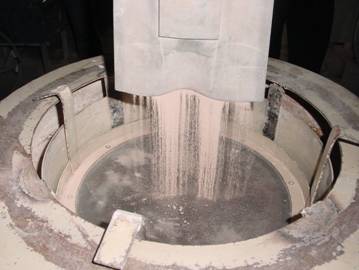Spray Drying Specialists Choose Low-Cost Alternative to Rotary Valve
 Spray drying is a method used to dry materials from a free-flowing fluid to a powder having specific requirements of shape and size. Heated air is used to vaporize the liquid from a slurry which has been atomized inside a drying chamber. Solids suspended in the slurry are rapidly dried and then drawn out of the drying chamber. The process results in the production of a powder which is collected for use in such industries as food, dairy, chemical, ceramics, and pharmaceutical.
Spray drying is a method used to dry materials from a free-flowing fluid to a powder having specific requirements of shape and size. Heated air is used to vaporize the liquid from a slurry which has been atomized inside a drying chamber. Solids suspended in the slurry are rapidly dried and then drawn out of the drying chamber. The process results in the production of a powder which is collected for use in such industries as food, dairy, chemical, ceramics, and pharmaceutical.
The discharge of these powders from the dryer chamber into the dust collection system is the final step in most spray drying processes. In order for the entire process to move smoothly, a reliable material handling valve is necessary.
 Anhydro, Inc., a global manufacturer of spray drying equipment, has long depended on a unique material handling valve for the reliable discharge of powders from the drying chambers and cyclone dust collectors on a number of its spray drying systems. For more than 30 years Anhydro has relied on non-powered automatic valves made by Aerodyne.
Anhydro, Inc., a global manufacturer of spray drying equipment, has long depended on a unique material handling valve for the reliable discharge of powders from the drying chambers and cyclone dust collectors on a number of its spray drying systems. For more than 30 years Anhydro has relied on non-powered automatic valves made by Aerodyne.
Stewart Gibson, process engineer in charge of industrial sales for Anhydro, has been specifying the Abanaki Vacu-Valve on “ceramics” spray drying systems since he joined the company 29 years ago. When asked why he prefers the Vacu-Valve to a more commonly used rotary valve the answer was “simplicity”. “The Vacu-Valve is a simple powder release valve that prevents ingress of air into the system, which is just what we needed.”
Anhydro is known in the spray drying industry for its use of energy-efficient components, plus the ease of operation and process automation that its equipment provides. The Vacu-Valve uses no electricity or controls and is a fraction of the cost of the rotary valve it typically replaces. The valve’s unique duck-bill rubber sleeve utilizes the negative pressure within the dust collection system to maintain a proper airlock seal. As collected material builds up above the valve, the sleeve is forced open to allow product to discharge from the hopper. The valve then re-closes automatically. The Vacu-Valve is available with a variety of sleeve materials to suit various application requirements.
Mr. Gibson specifies the Vacu-Valve on specific spray-drying applications in the ceramics industry. He says there are particular applications the valve is well suited to, namely those with “dense, free-flowing powders”. “The free-flowing nature of materials like ceramics makes this valve suitable for use” says Gibson. Gibson says he continues to choose Aerodyne’s Vacu-Valve for Anhydro, Inc. because of the “reduced maintenance and high reliability” it offers. With no controls or moving parts like the rotary valve, he said, it just works.

